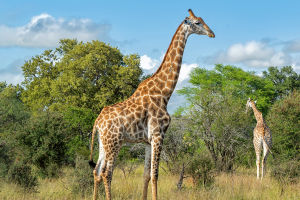The giraffe’s long neck is one of the most iconic and fascinating features in the animal kingdom.
Let’s dive into the science behind this remarkable trait and how it benefits giraffes in their natural habitat!
1. Feeding Advantage
One of the most common explanations for the giraffe’s long neck is related to feeding. In the savannah, where food can be scarce during certain seasons, giraffes benefit from being able to reach high branches that other herbivores cannot. Their necks allow them to feed on the tender leaves of tall trees, such as acacias, giving them access to food sources that other animals simply cannot reach.
2. Necking: A Tool for Mating Battles
Aside from feeding, the giraffe’s long neck also serves an important role in fighting. Male giraffes use their necks in a behavior known as necking, where they swing their heads like hammers to strike their opponents during fights for dominance. These battles are often about securing mating rights with females. The males with longer, stronger necks are typically more successful in these fights, giving them an advantage in passing their genes to the next generation.
3. Survival in the Savanna
The long neck is also advantageous for survival in the wild. Giraffes have a unique vantage point that allows them to spot predators, such as lions, from a distance. This extra height gives giraffes a better chance of spotting danger early, allowing them to escape or defend themselves before predators can attack.
4. Physiological Adaptations
The giraffe’s long neck comes with some impressive physiological adaptations to support it. For example, giraffes have a powerful heart—one of the largest of any land animal—that pumps blood up their long necks to reach the brain. Additionally, specialized valves in their arteries help manage blood flow and prevent fainting when they lower their heads to drink water.
5. Evolutionary Theories
The evolution of the giraffe’s long neck has been a topic of debate for many years. While the traditional theory, known as the competing browsers hypothesis, emphasizes the role of feeding, more recent research supports the necks-for-mating hypothesis, which suggests that sexual selection through necking plays an equally significant role in the evolution of the giraffe’s long neck.
Dear Lykkers! The giraffe’s long neck is much more than just a feeding tool. It is a remarkable example of how evolution can shape an animal’s body to fit multiple purposes, from accessing food in tall trees to defending territory and securing mates.
This adaptation has allowed giraffes to thrive in the harsh environments of Africa’s savannas!


